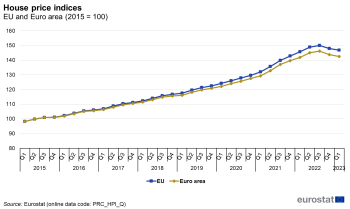This page is part of Statistics 4 beginners, a section in Statistics Explained where statistical indicators and concepts are explained in a simple way to make the world of statistics a bit easier both for pupils and students as well as for all those with an interest in statistics. An index shows the development of a number over time. It is not expressed in tons, euro or any similar common unit; it only shows the change of a figure from one point in time to another. For simplicity, the reference value, which may refer to a given year (base year), is usually set to 100. An index value of 110 then indicates an increase by 10 % compared to the value in the reference period.
Example
Total employment in country X is 5 million persons in 2015, 6 million persons in 2016 and 9 million persons in 2017. To see the change from 2015 and onwards, 2015 is set as a base year, which means that the value of the index in 2010 is 100.
The increase is calculated as follows:
(6 million/5 million) x 100= 120 = the value of the index in 2016
(9 million/5 million) x 100= 180 = the value of the index in 2017
Example of using a base year:
Further information
- Video Croatian Bureau of Statistics Indices


